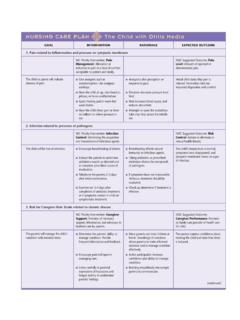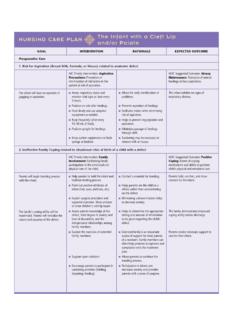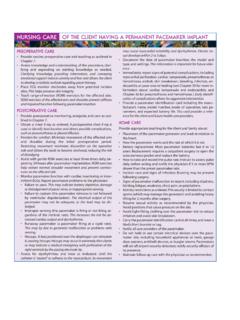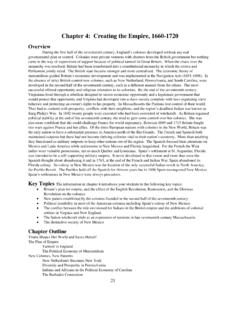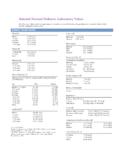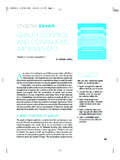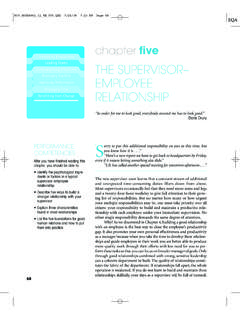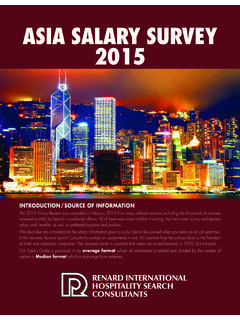Transcription of Chapter 13
1 Chapter 13. Managing Human Resources in an Chapter International Outline Business The Internationalization of Business How Intercountry Differences Affect HRM. Improving International Learning Outcomes Assignments Through Selection After studying this Chapter , you should be able to: training and Maintaining Explain how to improve international assignments through employee International Employees selection. International Labour Answer the question, What sort of special training do overseas Relations candidates need? . Safety Abroad Discuss the major considerations in formulating a compensation plan for overseas employees. Repatriation: Problems Describe the main considerations in repatriating employees from and Solutions abroad. Managing Human Resources in an International Business 2. The Internationalization of Business More and more Canadian-based companies are conducting their business in other countries. Huge global companies like Noranda, Labatt's, and Molson's have long had extensive overseas operations.
2 Global changes such as the rapid development of demand in the Pacific Rim and other areas of the world means that business success depends on the ability to market and manage overseas. Of course, to foreign companies like Toyota, Canada is overseas, and thou- sands of foreign firms already have thriving operations in Canada. Increasingly, companies must be managed globally, which confronts managers with several challenges. First, the number of their employees abroad has increased. With more International HRM Association employees abroad, HR departments have had to tackle new global challenges. Three broad global HR challenges that have emerged are as follows:1. Deployment. Getting the right skills to where they are needed in the organ- ization regardless of geographical location. Knowledge and innovation dissemination. Spreading state-of-the art knowledge and practices throughout the organization regardless of where they originate. Identifying and developing talent on a global basis.
3 Identifying who has the ability to function effectively in a global organization and developing these Dealing with such challenges means that most employers have had to devel- op HR policies and procedures just for handling global assignments. From a practical point of view, one has to address issues such as:3. 1. Candidate identification, assessment, and selection. In addition to the required technical and business skills, key traits to consider for global Among the many changes assignments include, for instance: cultural sensitivity, interpersonal skills, taking place in the interna- and flexibility. tional business arena is the 2. Cost projections. The average cost of sending an employee and family on introduction of the euro, a single currency used by the an overseas assignment is reportedly between three and five times the European Union since employee's pre-departure salary; as a result, quantifying total costs for a 1999. global assignment and deciding whether to use an expatriate or a local employee are essential in the budgeting process.
4 3. Assignment letters. The assignee's specific job requirements and associated pay will have to be documented and formally communicated in an assign- ment letter. 4. Compensation, benefits, and tax programs. There are many ways in which to compensate employees who are transferred abroad, given the vast differ- ences in living expenses around the world. 5. Relocation assistance. The assignee will probably have to be assisted with such matters as maintenance of the person's home and automobiles, ship- ment and storage of household goods, and so forth. 6. Family support. Cultural orientation, educational assistance, and emer- gency provisions are just some of the matters to be addressed before the family is sent 3 Chapter 13. That is just the tip of the iceberg. Cross-cultural, technical, and language training programs will probably be required. The complex and differentiated HR Links tapestry of labour laws and rules from country to country and provisions for re- assimilating the expatriate when he or she returns home are some of the other issues that must be addressed.
5 It is increasingly common for technology to be used to assist with global relocation. A WorldatWork survey found that 92 percent of expatriates say that the Internet is critical to their lives, and 96 percent say they use it daily. In Expatriate Information About Living Abroad future, it is expected that relocation stores will appear on the Internet, set up ~ by relocation companies for corporations and consumers to access for help with career services, cross-cultural training , stress management, and And over 80 percent of the Global 500 corporations (the 500 largest corporations in the workd) use their Web site for global Mobility Services International Second, sending employees abroad and managing HR globally is complicat- ed by the nature of the countries into which many firms are expanding. Employers today are not just transferring employees into the relatively familiar Expat Forum surroundings of industrialized nations. For example, Figure identifies 7 of the 15 countries chosen most often by 192 HR managers as among the three countries they see emerging as assignment locations for their organizations.
6 7. Notice the range of HR-related challenges that an employer can expect when assigning employees in some of these countries. In China, for instance, special Canadian Chamber of Commerce in insurance should cover emergency evacuations for serious health problems; tele- Hong Kong phone communication can be a severe handicap in Russia; and the compen- sation plan for employees in Mexico may have to deal with an inflation rate that approaches 52 percent per How Intercountry Differences Affect HRM. To a large extent, companies operating only within Canada's borders have the luxury of dealing with a relatively limited set of economic, cultural, and legal variables, as Canada is basically a capitalist competitive society. A company that is operating multiple businesses abroad is generally not blessed with such rela- While vacationers like these tive homogeneity. For example, minimum legally mandated holidays may range in Luxembourg are legally from none in the United Kingdom to five weeks per year in Luxembourg.
7 Entitled to five weeks' holi- Another troubling issue is the need for tight security and terrorism awareness day, standards vary widely training for employees sent to countries such as Colombia, where kidnapping of even within Europe. foreign executives is The management of the HR. function in multinational companies is complicated enormously by the need to adapt HR policies and procedures to the differences among countries in which each subsidiary is based. The following are some intercountry differences that demand such Cultural Factors: Wide-ranging cultural differences from coun- try to country demand corresponding differences in HR practices among a company's foreign subsidiaries. The cultural norms of the Far East and the importance there of the patriarchal system affect the typical Japanese worker's view of his or her relationship to an employer as well as influence how that person works. Japanese workers have often come to expect lifetime employment in return for their loyalty, for instance.
8 As well, incentive plans in Japan Managing Human Resources in an International Business 4. tend to focus on the work group, while in the West the more usual prescription is still to focus on individual worker incentives. A well-known study by Professor Geert Hofstede underscores other interna- tional cultural differences. Hofstede says that societies differ first in power dis- tance; in other words, they differ in the extent to which the less powerful members of institutions accept and expect that power will be distributed Individualism versus collectivism refers to the degree to which ties between individuals are normally loose rather than close. In more individualis- tic countries, all members are expected to look after themselves and their immediate families. 12 Individualistic countries include Canada and the United States. Collectivist countries include Indonesia and Pakistan. Masculinity versus femininity refers, said Hofstede, to the extent to which society values assertive- ness ( masculinity ) versus caring (what he called femininity ).
9 Japan and Austria ranked high in masculinity; Denmark and Chile ranked low. Such intercountry cultural differences have several HR implications. First, they suggest the need for adapting HR practices such as selection testing and pay plans to local cultural norms. They also suggest that HR staff members in a for- eign subsidiary are best drawn from host-country citizens. A high degree of sen- sitivity and empathy for the cultural and attitudinal demands of coworkers is always important when selecting employees to staff overseas operations. As one expert puts it, An HR staff member who shares the employee's cultural back- ground is more likely to be sensitive to the employee's needs and expectations in the workplace and is thus more likely to manage the company successfully. 13. Economic Factors: Differences in economic systems among countries also translate into intercountry differences in HR practices. In free enterprise sys- tems, for instance, the need for efficiency tends to favour HR policies that value productivity, efficient workers, and staff cutting where market forces dictate.
10 Moving along the scale toward more socialist systems, HR practices tend to shift toward preventing unemployment, even at the expense of sacrificing efficiency. Labour Cost Factors: Differences in labour costs may also produce differ- ences in HR practices. High labour costs can require a focus on efficiency, for instance, and on HR practices (like pay-for-performance) aimed at improving employee performance. Intercountry differences in labour costs are substantial. For example, hourly compensation costs in dollars for production workers in manufacturing recently ranged from a high of $ in Germany to a low of $ in Wide gaps also exist in hours worked. For example, work- ers in Portugal average about 1980 hours of work annually, while workers in Germany average 1648 hours. Employees in Europe generally receive four weeks of vacation as compared with two or three weeks in Canada. Industrial Relations Factors: Industrial relations, and specifically the rela- tionship between the worker, the union, and the employer, vary dramatically from country to country and have an enormous impact on HRM practices.

